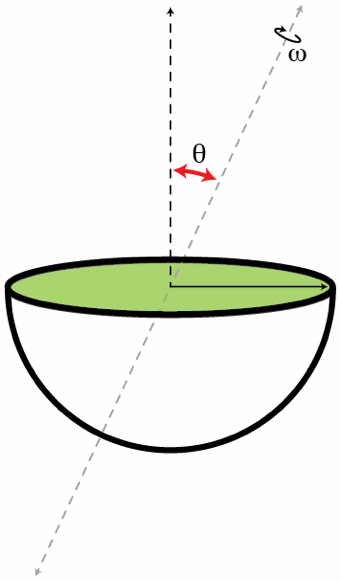Kinetic energy of a hemisphere

A solid hemisphere of radius R = 0 . 5 m and mass M = 1 kg rotates with angular speed ω = 1 0 rad/s about an axis passing through its center O and making and angle θ = 6 0 ∘ with the vertical (see the figure below). Determine the kinetic energy in Joules of the hemisphere.
The answer is 5.
This section requires Javascript.
You are seeing this because something didn't load right. We suggest you, (a) try
refreshing the page, (b) enabling javascript if it is disabled on your browser and,
finally, (c)
loading the
non-javascript version of this page
. We're sorry about the hassle.
2 solutions
Can you please explain how M.I. is independent of 'theta' ?
where did 'theta' go?isn't it related with angular speed?
Why don't you add K = 2 1 I ω 2 + 2 1 m v 2 ?
Log in to reply
That would have yielded the same answer.
Actually, the MOI i have calculated is not the one that passes through the center of mass.
Actually , K = 2 1 I p w 2 can be used directly , if I p is about an axis passing through stationary points. Let me show , how to do using
K = 2 1 I c m w 2 + 2 1 M v c m 2 .
Here , v c m = w d , and I c m = I p − m d 2 , where d is the perpendicular distance of c m from the axis shown .
Hence, K = 2 1 [ I p − M d 2 ] w 2 + 2 1 M ( w d ) 2
= 2 1 I p w 2 .
Here I p is used instead of I , as used in my solution.
what is moment of inertia
Let the mass of solid hemisphere be M .
Mass of solid sphere of which this hemisphere is a part = 2 M .
Moment of inertia of whole figure (sphere) = 5 2 × ( 2 M ) R 2
Moment of inertia of half the figure (hemisphere) = 2 1 × 5 2 × ( 2 M ) R 2 = 5 2 × M R 2
Kinetic energy = 2 1 × I ω 2 = 5
If you are still not convinced why I is independent of θ , look at the figure carefully and notice you can take out the left part of the hemisphere and place it on the top of the right part and it would form a complete a hemisphere. I would remain the same as the distance from the rotational axis is still the same before and after we made the transformation in the rotating object.
- Left and Right part refer to the part of hemisphere lying left and right with respect to the rotational axis.
- I means Moment of Inertia.
Consider , if there were two such hemisphere making a sphere of mass 2 M . Both hemispheres would have the same moment of inertia I . We will derive that I is independent of θ
Hence, 2 I = 5 2 2 M R 2 ⇒ I = 5 2 M R 2
K . E . = 2 1 I w 2 = 5 M R 2 w 2 = 5 .